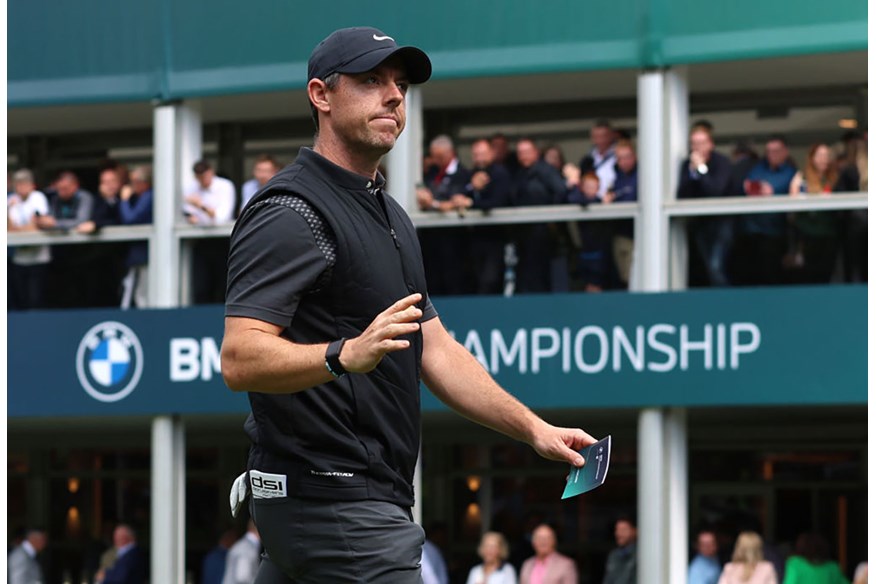I went to LIV Golf UK by JCB and this is what I thought
Last updated:
Two years on from LIV Golf’s first event, I attended its third UK tournament to see what the experience is like, how LIV is progressing, and whether this is the future of golf.
It is just two years ago that the LIV golfing revolution was launched at the Centurion Club in St Albans. It was a remarkable debut, a week in which the atmosphere crackled with energy, but that was largely a consequence of the rebellious nature of the breakaway. It was only when the players hit their first tee shots, for example, that the PGA Tour released a statement detailing the sanctions that would be imposed on the renegades.

That inaugural tournament was also, of course, notable for LIV unveiling its first off-the-course experience, something they promised would transform the sport. Now in its third season, how would this year’s LIV UK compare with that first edition?
Insiders did admit that there were some concerns that moving the showcase from a venue near London to the JCB Golf & Country Club in Staffordshire might impact fan numbers, but those concerns were swiftly allayed when it sold out in quick time.
And once fans were inside the property – and for many that proved troublesome owing to poor traffic control – it was clear that LIV UK 2024 was bigger, better, and brasher than the 2022 edition. LIV now has more staff, the infrastructure is more significant, and the options for fans are apparently endless.
There are also, rather simplistically but effectively, more loudspeakers playing dance tunes. In the summer sunshine, the entire vibe was very different to golf’s past. Less the Honourable Company of Edinburgh Golfers. More Wayne Lineker Mediterranean bar scene.
The range thumped with energy, the putting green was like a VIP area, the Birdie Shack bounced, the Digger Inn was rowdy, and the Majesticks Arms was a boisterous firm fan club favorite.
Kids could be introduced to the sport with fun games, have their swings improved by instructors, or just muck about in a JCB sand pit. Both children and grown-ups could test their rugby ball passing skills, their football free kick prowess, and chip golf balls on a JCB digger-themed mini-range.
The merchandise store was something of a curiosity in 2022. The team ethic was new and awkward. Two years later, caps, shirts, and hoodies were flying out the doors.
Fans indulged in food and drink. Lots and lots and lots of both. There were loaded fries, loaded nachos, loaded wings, and, presumably, loaded pockets.
In the middle of the fan village were two ruined towers, their faded grandeur surrounded by electric colors and boozy punters. Given that everything else had a title it was slightly surprising that no one had thought to name these two crumbling piles after the PGA and DP World Tours.
It was evident that many fans were having a great time and not actually watching the golf. Moreover, they had arrived well before the start time and many would leave long after, staying to watch the free gig.
“There’s a definite NFL vibe,” said someone, walking the fairways, noting that when the NFL comes to London it is common to be so involved with the periphery activities that the notion two teams are involved in a match can get forgotten.
While this would be true of certain elements of LIV UK’s paying punters, it’s not the complete story. In fact, proximity to the fan village and various hospitality units was largely relative to concentrated interest in the action. By the time you got to the furthest corners of the property, the tournament was much like any other – a few diehards enjoying being close to the action, politely clapping excellent as well as very average shots into the greens.

It was easy to walk the holes and think: “This is what Golf Sixes could have been.” Remember that? Keith Pelley’s attempt to bring tournament golf into the 21st century, it fizzled out because the stars weren’t incentivized to play and the budget was mediocre. Not enough money, in other words. It lacked PIF’s bottomless pockets.
Modern sport, of course, has a dilemma. There are those diehards who love the games they support but the executives are afraid that they don’t spend enough money, that there aren’t enough of them, and that they’re dying out.
English cricket’s answer is The Hundred. The men and women behind it freely admit that they are chasing a new audience in order to safeguard the game’s future. Their answer is to create a new version of the sport which is hated by many of those who love the original.
In many ways LIV Golf is fighting a similar battle. One fan said: “It doesn’t really feel like sport – who’s winning doesn’t seem to matter.” Others were loving it and one even cited Elon Musk before crying: “LIV is a disruptor. It’s disrupting the sport.”
The sports business journalist Richard Gillis of Unofficial Partner has regularly noted how sport is being hustled into becoming entertainment, and LIV slots right into that trend.
Back in 2017 the irreverent Gillis wrote: “Normal, unassuming people have been marginalized as sponsors pursue a sinister new agenda called ‘fan engagement’, the basic objective of which is to encourage young men to behave like complete bell-ends.
“Sport is the medium, ‘act like a twat at the office Christmas do’ is the message.
“The modern fan is expected to bring something more to the party than quiet enthusiasm and deep subject knowledge; they must come ready to demonstrate their Passion For Sport™.”
These thoughts came to mind when Marc Leishman dunked an approach shot into a front bunker at LIV UK’s 15th hole and one fan, already unsteady with booze, turned to his mates, also leaning a little too far the wrong way on the slopes, and said: “On that note, let’s stop watching this shit and drink more beer.”
LIV might appeal directly and unapologetically to this demographic but such scenes are by no means exclusive to the rebel circuit in modern sport or within golf.

The BMW PGA Championship at Wentworth is undoubtedly a tremendous experience for fans, with an excellent course, an excellent field, and an excellent fan village that includes free gigs at the weekend.
But the focus on having a good time has a flipside. The Friday Night Racing Crowd flipside. Back in 2018, Rory McIlroy played in the final group of the third round and spent the first three holes staring around in bewilderment.
Drunken spectators casually broke the ropes down the first fairway and wandered across the line of the hole at the par-3 second. When McIlroy departed the third green more drunks ventured onto the green and took selfies. The marshals who tried to stop them were brushed off and told where to go (and it wasn’t the fourth tee).
There was a similar scene at Royal Troon 90 minutes after Xander Schauffele lifted the Claret Jug, when another wobbly fan decided to run onto the 18th green and was chased by security staff in a scene reminiscent of streakers running onto a test match cricket ground. Open marshals talk of how crowd behaviour is increasingly difficult to manage partly because of the excesses of alcohol, but also because of an increased sense of entitlement.
It’s a fascinating world. A complicated world. It’s golf’s future and “Quiet please!” is an increasingly antiquated plea.


